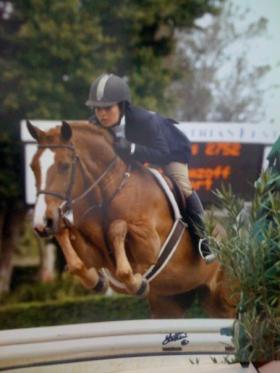The European training program and the American training program—at least the one I know—are very, very different. For starters, many of the stables here breed many of their own horses, and as such, constantly have new young horses to bring along. Each year, the horses that are 3 and turning 4 years old are evaluated for performance and soundness by free-jumping and x-rays, respectively. Those who exhibit great potential and have clean x-rays are then sent to a cowboy to be saddle broke for a few months, before returning to the stable’s training program.
As 4-year-olds, the horses learn how to walk, trot, and canter in a frame, they learn to bend, pick up the correct leads, do their flying changes, and then once they have all of that down, they begin to learn to jump. Yesterday, I had the opportunity to jump one of the 4-year-olds who had never jumped before and it was so much fun!
You can really tell the true “jumping horses” when you go to jump them for the first time. Even though they don’t really know what they are doing yet, the good ones really want to jump; they get excited, as it is after all, what they were born to do. After learning to jump, they begin going to horse shows, or “concours” as they are called in Dutch, where they start out jumping .80-meter or 1.00-meter classes and progress throughout the levels (BB-ZZ) as they get older (I will go into much greater detail regarding the horse shows/levels next time).
The training program here is perhaps best described as a cross-training program, which is great for not only keeping the horses’ bodies sound, but also their minds happy. At least one, if not two, days a week, we take the horses on the trail, which is about 30-40 minutes of trotting and cantering, topped off by racing home. I have to say, there are few things in life that parallel galloping full tilt down a path in the middle of Holland on a cool summer morning. The horses absolutely love it, and we usually go in sets of a younger horse and an older horse, as the older horses know the trail and this way the younger horses catch on very quickly. Additionally, the older horses know exactly where the turn to race is, so if the younger ones were not aware, they figure it out real quick.
ADVERTISEMENT
Each horse also spends one day per week training on the lunge line; the horses wear a bitting rig that is set four holes shorter on the inside than on the outside. The lunge line is then channeled through the bit on the inside and attached to the girth billet on the inside, which allows the person lunging the ability to do dressage from the ground. First the horses go out on the bigger circle, and then we take them on a smaller circle, using the lunge line as leverage to get the horses to give and take, bending and releasing. I had never seen a bitting rig used like this before, but it is an extremely valuable tool as it really teaches the horses how to carry themselves and allows them to develop the muscles necessary to do so.
In terms of riding, I am learning how to ride in a completely different style than I have been riding in for the last 18 years. It is a welcome challenge, and I am finding it fascinating to learn how to ride in an entirely different way. Let’s just say I had never even attempted the German style of riding prior to 10 days ago, and as such, it is a work in progress.
I am finding that what used to be second nature, I now have to think about doing constantly, in a way that greatly differs from those old familiar second nature habits. However, that being said, when you’re really thinking about it, you have these fabulous epiphanies I typically think of as ‘rider revelations’—you know when you’re trying to figure it out, and then all of the sudden it just clicks. Once it clicks, and you know what you have to achieve, it is much easier to get back to that point as you then know what it is you have to get to. I have also been doing a lot of watching, and have had almost as many revelations watching as I have had riding.
I could go on and on, but until next time, Haije!















